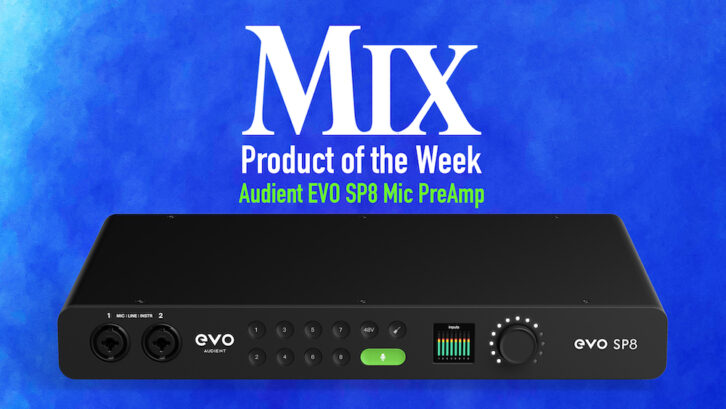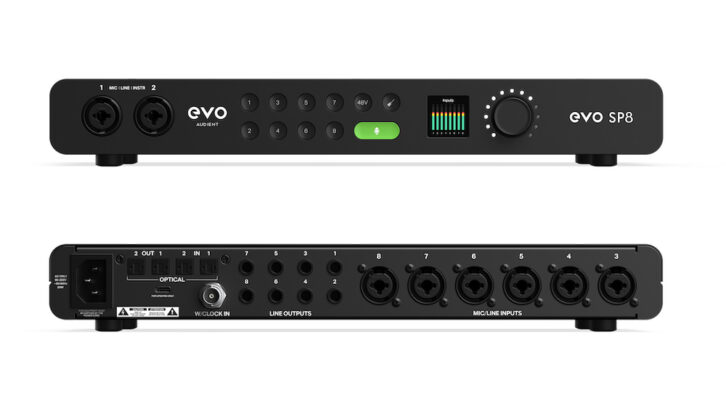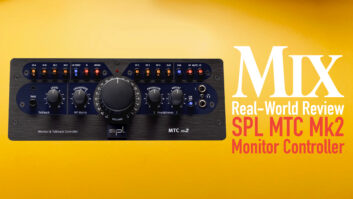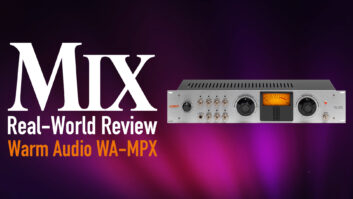
| MIX VERDICT: AUDIENT EVO SP8 ‘SMART’ MIC PREAMP |
| THE TAKEAWAY: “The EVO SP8 delivers the goods at a very reasonable price. ” |
| COMPANY: Audient • www.audient.com PRICE: $499 PROS: • Very good sound quality. • Easy to use. • Useful Smartgain feature. • Elegant integration with EVO 16. CONS: • May not have enough gain for low-output microphones. • Mixer app screen is difficult to read. • Locks up when sent external clock at 176.4 or 192 kHz. |
The EVO SP8 from Audient is an eight-channel “Smart” microphone preamp with onboard A/D and D/A, and dual ADAT optical I/Os. It can be used as a stand-alone, digitally controlled analog mic pre, or as a way to expand the channel count of any audio interface with ADAT optical I/O, but taking full advantage of its Smart capabilities requires combining the EVO SP8 with Audient’s EVO 16 (24×24) USB interface.
A maximum of two EVO SP8s may be connected to an EVO 16 for creating an “EVO Expanded” recording system with 24 channels of I/O at sample rates up to 48 kHz (sample rates of 88.2 and 96 kHz require use of dual optical ports, reducing channel count).
The EVO SP8 is built into a solid, all-metal chassis with roughly the same footprint as a mid-size laptop (rack ears are available as an option). Front-panel features include two mic/line/instrument combo jacks, eight channel-select buttons, 48 VDC phantom on/off, instrument and Smartgain buttons, high-res LCD screen, and a rotary encoder for entering data.
The rear panel hosts six balanced combo jack inputs, eight balanced TRS line outputs, (2) ADAT optical I/O, BNC word clock input, a USB Type-C port (for firmware updates), and an IEC power receptacle.

GETTING SET UP
The first time the EVO SP8 is powered on, a screen prompt guides you through a brief setup procedure to adjust basic parameters such as screen brightness, clock source, analog output source and sample rate. To revisit these settings or access other system parameters, press and hold the encoder until the Setup menu appears.
Most of the Setup menu settings are self-explanatory, but a few are worth mentioning. Clock Source options include Internal, Digital or Word Clock. Sample Rate can be set to 44.1, 48, 88.2 or 96 kHz, or Auto, whereby sample rate is derived from the clock source. Output Source switches the TRS outputs to source audio from one of two paths: The first option is “Analogue,” in which case the jacks output signal from the mic preamps, post-gain, enabling you to use the EVO SP8 as you would any stand-alone analog microphone preamp, while providing redundancy via the optical output. The other option for Output Source is “Digital,” in which case the EVO SP8 acts as a D/A for audio routed to the ADAT optical input.
Audient refers to the UI for the EVO 16 and EVO SP8 as the “Motion UI,” which makes getting around fast and easy. Tap on a channel button and turn the encoder to adjust gain for that channel; press “48V” to turn phantom power on/off. The instrument button applies only to front-panel inputs 1 and 2 and engages a JFET DI for either of those channels. When in instrument mode, phantom power cannot be turned on; attempting to do so causes an angry ghost to appear on the LCD!
The EVO SP8 and the EVO 16 have a feature called Smartgain, which automatically sets input level, either on a per-channel or global basis. While running Smartgain, the preamp “listens” to the input source for about 10 seconds and sets gain accordingly.
Smartgain settings were almost identical to the values I’d have set manually. One exception was using Smartgain for multiple microphones on an entire drum kit simultaneously: Due to leakage, Smartgain had difficulty determining preamp level for the hi-hat mic, but if I initiated Smartgain only on the hi-hat channel, and played only the hi-hat, Smartgain worked fine. When the Smartgain process has finished, colored circles show status (success or failure) for each channel.
I initially used the SP8 with my main interface, a Metric Halo Labs LIO8, and Digital Performer. Word clock out from the LIO8 was connected to the EVO SP8, and optical out from the EVO SP8 was patched into the LIO8, expanding the analog input count by eight. The EVO SP8 synched without any issues, but there was one repeatable glitch: If I changed the LIO8 sample rate to 176.4 or 192 kHz, the EVO SP8 would lock up and mute. The only way to resume normal operation was to restart the EVO SP8. Other than that, changes to the sample rate were properly acknowledged by the EVO SP8.
HOW DOES IT SOUND?
Audio quality from the EVO SP8 is very good. It’s not as transparent as the LIO8, but bottom end is solid and tight, while the midrange and top end are smooth and clear. The preamps and converters lean toward the warm side of the spectrum, so if you hear any harshness, you can be sure it’s either the source or the microphone. There’s a subtle color happening in the EVO SP8, but it’s tough to pinpoint, even using an RTA, which suggested a very slight (1 or 2 dB) shelf from 250 Hz down.
EVO SP8 preamps have plenty of gain to accommodate most microphones, but struggled with my RCA 44BX (most preamps do), which requires tons of gain and is very sensitive to input loading. The EVO SP8 didn’t quite have enough gain to amplify the 44BX to nominal levels on acoustic guitar or vocal recordings, and some background noise was evident at the maximum gain setting (58 dB). If your plans include using a low-output dynamic mic with the SP8, you may need a Cloudlifter-type device to make up the difference.
The DI inputs sounded equally good. Plugging in a Strat and switching the input to Instrument mode made the guitar come to life with crystal-clear high end, plenty of detail and a balanced frequency response. The guitar sounded like a Strat should, especially noticeable when using amp simulator plug-ins.
BRING IN THE EVO 16
When I asked the folks at Audient to send me an EVO SP8, they suggested that I try the unit with an EVO 16, and I now see why: The two make an excellent pair. Documentation states that pressing Smartgain on one device in an Expanded system turns Smartgain on for all of the devices. Given that the EVO 16 is connected to a computer via USB, while the EVO SP8 has no connection to the computer, I was expecting this to be propaganda.
At this point, I had a cable connecting the EVO SP8 optical out to EVO 16 optical in (which routed audio successfully), and the feature didn’t work—but then I had a very sneaky thought: What if Audient figured out a way to use the ADAT optical bus to carry additional data without interfering with the digital audio? I connected another optical cable—this one from EVO 16 optical out to EVO SP8 optical in—pressed Smartgain, then lo and behold Smartgain was initiated for both units. My propeller hat off to the engineers at Audient.
Soundtoys SuperPlate Reverb – A Mix Real-World Review
An all-EVO system with these connections also enables you to take full advantage of the EVO mixer app. As you’d expect, the app provides access to all of the EVO 16 front-panel controls, plus adds control over four cue buses, facilitates low-latency monitoring and allows settings to be stored and recalled. When an EVO SP8 is connected, its channels automatically populate the mixer app, and the app controls preamp gain, fader level, pan, solo, mute and phantom power for all devices on the optical network. Very clever.
Not so clever is the color scheme for some of the mixer app’s controls and text. I found the phase button almost impossible to find, while 48 VDC, mute, solo and mono buttons were difficult to see, as was some of the text. One thing to be aware of is that you cannot use the mixer app with only an EVO SP8—an EVO 16 is required to bridge communication between the EVO SP8 and the app.
EXCELLENT VALUE
It’s obvious that Audient did a lot of homework when designing the EVO SP8. In addition to Smartgain and the voodoo of two-way communication via the ADAT optical bus, the company has incorporated other smart features, such as automatically muting the output when phantom is switched, or the ability to mute a channel simply by pressing and holding the channel button. Channels can be easily linked, and clipping an input causes the illuminated number at the center of a channel button to change from white to red. Even a firmware update was easy, given an Internet connection.
Whether you plan to use it as a stand-alone mic preamp, expander via ADAT optical for your existing interface, or as a complement to an EVO 16, the EVO SP8 delivers the goods at a very reasonable price.







